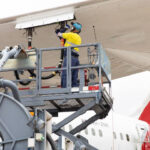Four prototypes of zero-emission aircraft and powertrains are being readied for test flights in Australia and New Zealand during 2025 as both markets accelerate efforts to decarbonise their aviation sectors, starting with short-distance routes. In April, Air New Zealand will start testing a battery-electric Alia CX300, built by US-based BETA Technologies, before introducing the type for regional freight flights in 2026. In Australia, Brisbane-based Stralis Aircraft will perform the first flight of its locally developed hydrogen-electric powertrain, Sydney’s AMSL Aero will fly its new Vertiia VTOL, also with hydrogen-electric power, and Melbourne-based Dovetail Electric Aviation will convert a Cessna Caravan to battery-electric propulsion. All four programmes coincide with a recent reshaping of the global market for new zero-emission aircraft and propulsion systems, with a range of projects progressing while others have restructured, rescheduled or failed.
As part of the Mission Next Gen programme to decarbonise its domestic fleet, Air New Zealand plans to introduce the conventional take-off and landing (CTOL) Alia CX300s into service from 2026 to carry small freight consignments in partnership with New Zealand Post on short routes between and within the nation’s two main islands.
Air New Zealand has also announced that from April – one year earlier than planned – a testbed of the aircraft, electrically-propelled by a single, rear-mounted propeller, will arrive in New Zealand for use as a technical demonstrator.
It has also signed a letter of intent with commercial aircraft lessor Avolon for the sale and leaseback of one CX300 aircraft, with capacity to carry up to 560 kilograms of freight.
Additionally, the companies agreed to work together to research the commercialisation of electric aircraft and new, zero-emission propulsion technologies including battery, hybrid and hydrogen.
“Lessors have an important role to play in supporting the commercialisation of clean tech aircraft,” said Avolon’s CEO, Andy Cronin. “This partnership with Air New Zealand reflects Avolon’s commitment to supporting innovation, building on our investment in Vertical Aerospace and our involvement with Airbus’ ZEROe project.”
Air New Zealand’s first CX300 is due for delivery in 2026 and will be used by Air New Zealand to carry cargo between Wellington and Blenheim in partnership with New Zealand Post.
Initially, the Air New Zealand CX300 testbed will be based at Hamilton Airport, from where it will perform a series of proving flights, before the airline and aircraft manufacturer start flying it to a range of nearby airports. It will then go to the national capital, Wellington, from where it will be flown to locations including Blenheim, on the South Island, a route the planes will fly commercially from 2026.
The airline has used its Climate and Nature Fund to invest in 60kW mobile chargers to be based at Hamilton, Wellington and Blenheim airports.
Kiri Hannifin, Air New Zealand’s Chief Corporate Affairs and Sustainability Officer, said earlier introduction would enable the airline to familiarise pilots and ground staff with the electric planes, while showcasing the craft in the communities they will serve.
“Some of our Air New Zealand pilots will have the opportunity to learn to operate the aircraft alongside BETA pilots,” said Hannifin. “This not only allows them to gain experience on a completely new type of aircraft, but it will also guide the airline’s work to develop the processes and policies required to operate the aircraft commercially in 2026.”
Added BETA founder and CEO Kyle Clark: “The tech demonstrator and chargers will allow us to collect data and refine the operations so Air New Zealand can hit the ground running with low-cost electric service upon delivery of their first certified aircraft.”
In a separate deal, New Zealand Air Ambulance Service has also announced a deposit-backed order for two BETA Alia eVTOLs (electric vertical take-off or landing aircraft) and options to acquire up to 10 more for regional medivac services. These aircraft will be equipped with four two-blade lift propellers and a one five-blade propulsion propeller.
In Brisbane, Stralis Aircraft has just completed a hydrogen-electric powered propeller spin on a decommissioned Beechcraft Bonanza A36 aircraft called ‘Clyde’, which is now used as a ground test rig.
The test, claimed to be the first of its kind in the Southern Hemisphere, was performed at the company’s base in the Aviation Australia complex on the edge of Brisbane Airport, using fuel cells and gaseous hydrogen.
By Q3 2025, after further refinement, Stralis plans to instal a prototype powertrain into a second Beechcraft Bonanza, known as ‘Bonnie’, for the system’s first flight.
The hydrogen-electric powered plane will then be tested in South-East Queensland to further develop the propulsion system for the company’s next project, conversion of a 19-seat Beechcraft 1900D commuter aircraft to a 15-seat variant, the 1900D-HE, to be powered with liquid hydrogen.
Stralis is targeting 2028 for this aircraft’s first flight, and 2029-30 for certification and entry into service.
It is also using these programmes to further refine its hydrogen-electric powertrains for an all-new 50-seat airliner, currently designated as the SA-1-HE, which the company expects will deliver 3,000-kilometre flight range. Designed is expected by the early 2030s, with certification and entry into service anticipated by 2036.
The hydrogen-electric powered propeller spin at Brisbane Airport was “a huge win for Stralis,” said founder and CEO Bob Criner. “We have safely trialled the introduction of hydrogen in a controlled environment at Brisbane Airport for use in aircraft propulsion, which required strong collaboration and upskilling of everyone involved.
“This lays the foundation and builds momentum as we work towards Australia’s first hydrogen-electric flight this coming year.”
In addition to seed funding from investors including US-based Y Combinator, Liquid 2, Trucks Venture Capital, Collaborative Fund Management and Climate Capital, the Brisbane Airport prop-spin milestone was backed by a grant from the Australian government’s Emerging Aviation Technology Partnerships Programme.
Sydney-based start-up AMSL Aero is also preparing for a hydrogen-electric powered flight this year of its Vertiia VTOL aircraft, having recently performed the machine’s first untethered flight with battery-electric power. That test flight was performed by remote control in regional New South Wales, west of Sydney.
AMSL is targeting 2027 certification and entry into service of the hydrogen-powered version, which is designed to fly up to four passengers and a pilot up to 1,000 kilometres at a cruise speed of 300 km/h.
The company is also developing aeromedical and freight versions of the aircraft, as well as an autonomous drone version for firefighting, enabling 24-hour access to major fires which are inaccessible by road or crewed aircraft.
Andrew Moore, AMSL’s co-founder and Chief Engineer, and Vertiia’s inventor, said the battery-powered free flight was “proof that the design we pioneered seven years ago works.”
He added: “It moves us closer to our goal of improving the lives of remote, rural and regional communities in Australia and around the world with an aircraft that conquers the tyranny of distance with zero emissions.”
In Melbourne, the Australian-European company Dovetail Electric Aviation is progressing the first flight of a battery-electric Cessna Caravan, having completed ground-rig propeller spins powered by its new propulsion system.
The company is targeting certification and entry into service during 2026. Tourist airline and Dovetail co-founder Sydney Seaplanes is the first customer, with plans to deploy amphibious versions of the aircraft.
Dovetail is also advancing a hydrogen-electric propulsion programme, and plans to convert a twin-engined Beechcraft King Air in 2026, targeting certification the following year.
Conversion centres are also planned in both Australia and Spain from 2027 to retrofit existing aircraft with new powertrains, ahead of the 2029 launch of an all-new regional airliner, the zero-emission DAX-19, which is planned for entry into service by 2033.
Photo: BETA Technologies’ Alia CX300 in Air New Zealand livery















More News & Features
Australia announces A$1.1bn incentive scheme to drive local production of low carbon fuels including SAF
COMMENTARY: China poised to evolve from rule-taker to rule-shaper at ICAO Assembly
COMMENTARY: Why China’s national carbon market is unlikely to include aviation in the near term
SAF production and procurement deals inked in China and other Asia regions
Air India signs MoU with IndianOil for SAF supply to meet country’s 2030 blending target
Aviation and fuel industries call for urgent EU policy action on SAF deployment